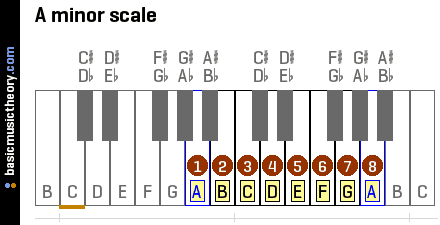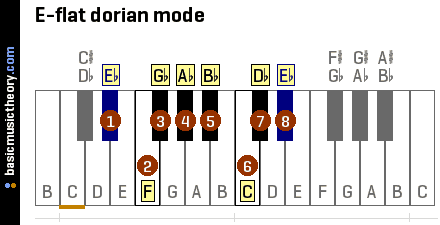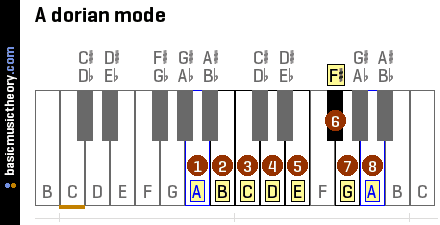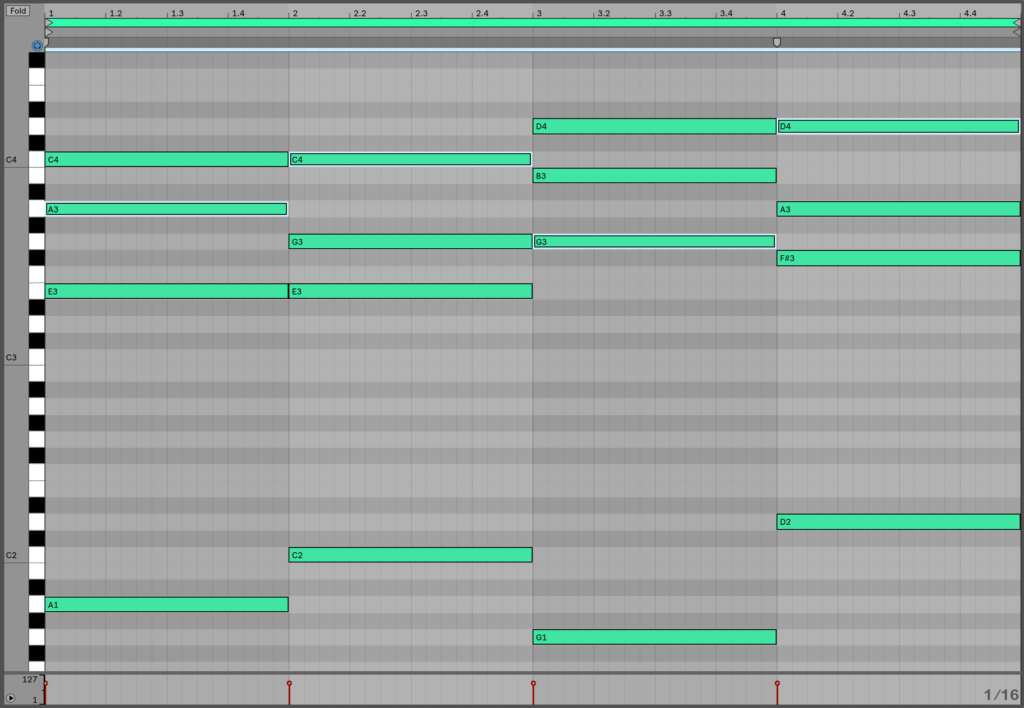(This is part 2. For part 1 of this article, click here)
Learning the Dorian Mode
Let’s look at the A minor scale, which is all white notes starting on A.

There is only a one difference between minor and dorian: the sixth.
In a minor scale, the 6th scale tone is a minor sixth (8 semitones) above the root.
In the dorian mode, the 6th scale tone is a major sixth (9 semitones) above the root.
(If you need a refresher, here’s an interval chart)
Let’s look at A dorian. As you can see below, A minor and A dorian are nearly identical, only A dorian has an F# instead of an F

How do we build a dorian scale?
If you’re familiar with minor scales, all you need is to build a minor scale and raise the sixth up a semitone.
Alternatively, recall that there is a formula to build a minor scale off any note. “W” represents a whole step and “H” represents a half step.
Minor Scale Pattern: W – H – W – W – H – W – W
There is also a formula for building a dorian scale:
Dorian Scale Pattern: W – H – W – W – W – H – W
Using this pattern, you can build a dorian scale off any note.
Get 25 high-quality MIDI chord progression files for free 🎹
Our Track Breakdown MIDI Vault is packed with chord progression MIDI files from songs like Mura Masa’s ‘Lovesick’, Flume’s ‘Say It’ & more! 👇
How to Write a Dorian Chord Progression
If you haven’t already, read the section on writing a mixolydian chord progression.
The same rules apply to writing a dorian chord progression: Build a chord progression using diatonic triads, focusing on using the color chords.
In the dorian mode, the color chord is the four chord.
To see why, let’s compare the diatonic triads of A minor with A dorian.
For reference, here are the seven diatonic triads in the key of C major.
| A Minor | Chord |
| 1 | A Minor: A-C-E |
| 2 | B Diminished : B-D-F |
| 3 | C Major: C-E-G |
| 4 | D Minor: D-F-A |
| 5 | E Minor: E-G-B |
| 6 | F Major: F-A-C |
| 7 | G Major: G-B-D |
Now, let’s look at the diatonic triads in A dorian.
| A Dorian | Chord |
| 1 | A Minor: A-C-E |
| 2 | B Minor : B-D-F# |
| 3 | C Major: C-E-G |
| 4 | D Major: D-F#-A |
| 5 | E Minor: E-G-B |
| 6 | F# Diminished : F#-A-C |
| 7 | G Major: G-B-D |
In a minor key, the four chord is minor. However in the dorian mode, the four chord is major.
Because the four chord is major, it catches people off guard. They expect to hear a minor four chord, but instead are given a major chord.
This adds to the dark, yet hopeful sound of the dorian mode.
To illustrate this, let’s look at an example of a Dorian progression.
Below is a progression in A dorian.
The progression is: Am – C – G – D
Numerically, this is i – III – VII – IV.
Listen below, paying attention to the color chord at the end.
Listen:
I love the dorian mode because it has the gloominess of a minor key with a hint of hope.
Here are a few popular dorian songs:
- Eleanor Rigby by The Beatles
- Wicked Games by Chris Isaak
- Get Lucky by Daft Punk
As well as Hindsight by Audien.
Recommended: The Lydian Mode – A Secret Scale for Colorful Music
Dorian Track Analysis: Hindsight by Audien
Audien’s Hindsight is in Eb dorian.

Pop quiz: What is the color chord of Eb dorian?
It’ll be the four chord, which means it’s Ab.
Let’s look at the main chord progression in Hindsight.
Listen:
What are we working with?
The progression is: Gb – Bbm7 – Ab – Ebm7
Numerically, this is III – V7 – IV – i7.
What makes this progression work?
The entire progression is one strong movement towards the one chord.
It starts off on the three, moves up to the five, moves down to the color/four chord, then lands on the one. Everything in this progression is moving “home” to the one.
We saw this same movement in Madeon’s Imperium, where the entire progression led to the I.
This is a great example of a progression that doesn’t start on the one.
Starting with the one chord is a great way to establish the key/tonal center of the track. However, starting with a different chord gives you the opportunity to tease the listener, revealing the one chord later one.
Let’s do a quick recap of this section.
Quick Summary
- To build a dorian scale, build a minor scale and raise the sixth up one semitone.
- To build a dorian progression, find the seven diatonic triads, then build a progression just like you would in a major or minor key, keeping the following in mind:
- The one chord is good to start with, but you can also tease the listener by introducing it later on.
- Use the color chord, which is the major four chord.
- Another good choice is the seven chord, which is a secondary color chord.
Want free access to the Track Breakdown MIDI Vault? You can download the MIDI from all of our Track Breakdowns, as well as 25 hi-quality MIDI chord progressions you can use in your own productions.
Get 25 high-quality MIDI chord progression files for free 🎹
Our Track Breakdown MIDI Vault is packed with chord progression MIDI files from songs like Mura Masa’s ‘Lovesick’, Flume’s ‘Say It’ & more! 👇
Conclusion
I hope you were able to take away some useful tips from this article. Learning proper songwriting is a difficult process, so I want to help make the journey as easy as possible for you.
I tried to pull out as much valuable information as I could from this song, helping you to better understand what makes a great song, well, great.
There’s a good amount of information to digest here, so I’d recommend re-reading it a few times to soak up all the different elements.
The point isn’t to memorize everything in this article, but to let this article guide your workflow, adding additional tools to your music-writing arsenal.
Lastly, if there are any songs you’d like covered, please let me know!
Want to read more breakdowns? Click here to visit the Track Breakdown Glossary.
Disclaimer:
The transcriptions aren’t 100% exact, but they’re essentially there. The point of this article wasn’t to exactly copy the song; rather, I wanted to get the general idea of the melodies and chords, so as to further break them down. Also, there are certain subtleties I left out to make the teaching more direct and effective.




